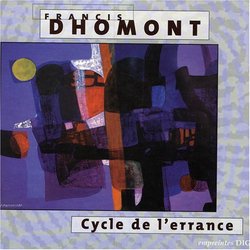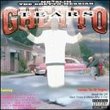| All Artists: Francis Dhomont Title: Cycle de l'Errance Members Wishing: 0 Total Copies: 0 Label: The Orchard Original Release Date: 1/1/1999 Re-Release Date: 3/25/2000 Genres: Dance & Electronic, New Age, Pop, Classical Style: Dance Pop Number of Discs: 1 SwapaCD Credits: 1 UPC: 669910143926 |
Search - Francis Dhomont :: Cycle de l'Errance
 | Francis Dhomont Cycle de l'Errance Genres: Dance & Electronic, New Age, Pop, Classical
|
Larger Image |
CD DetailsSimilar CDs
|
CD Reviews"A vertigo of multiple elsewheres..." Steve Benner | Lancaster, UK | 08/18/2002 (5 out of 5 stars) "Three tape works from one of the most influential of modern acousmatic composers, Francis Dhomont, are gathered here under the general title of "Cycle de l'errance (Cycle of Wanderings)" - formerly the first part of the 2-CD set, "Mouvances - Métaphores (Movements - Metaphors)" but now re-released as a stand-alone disc. This cycle (or, more accurately, triptych) begins with the 12-minute work "Points de fuite (Vanishing points)". Dating from 1982, this piece was largely written to throw off the weight of the monumental "Sous le regard d'un soleil noir", completed the year before. Drawing less on any visual or graphical associations of the title as a whole, and more on the connotations of the word "fuite" - flight - with the contrast between that word's implied line of movement and the essentially fixed, dimensionless nature of singularities - as referenced in "points" - the work provides an acousmatic metaphor for travel and for movement, on both the large scale and the small. It features rushing, unpitched masses of sound, surging in violent and enveloping waves; or else racing from point to point, etching lines of energy within the receptive mind. The resultant ever-changing, ever-constant, deep reverberating electronic and computer-generated textures make for a veritable tour de force: a masterwork, clamouring for a level of attention that simply cannot be withheld. Shortly after the completion of "Points de fuite", Francis Dhomont was appointed as a lecturer at the Faculty of Music of the Université de Montréal. Rather than emigrate, however, he chose to divide his time equally between his new teaching commitments in Canada and his established family home in Marseilles, in the south of France - something which he has continued to do ever since. It is not surprising, therefore, that the theme of motion, generally, and of constant travel and restlessness, in particular, should have occupied his compositional attention to no small degree over the intervening years.The nine movements of "...mourir un peu (...to die a little)", composed over a three-year period between 1984 and 1987, expand on the ideas behind "Points de fuite". Taking its title from the old adage, "to leave is to die a little", this work is packed with sonic allusions and alliterations built upon countless explorations of multiple threads, all on the theme of travel - departure, farewells, escape, loss, memory, pleasure, distance, etc. It is testimony to this composer's creativeness that is he able to expand the ideas of the earlier short work up into a far more substantial affair without ever once permitting the musical ideas to wear thin. These 45 minutes pass in what feels like no time at all and, as in just about everything this composer produces, without a single dull moment. Apart from the more obvious (real-world) sounds of transportation (especially aircraft and trains) and clear connotative items like the noise of stones rolling around (a rolling stone... geddit?) - some of which are truly gorgeous, by the way - the work is also permeated by the ever-present imagery of the sea. This gains a relevance not only for the role that the sea frequently plays in the partings of people (particularly pertinent in the life of this composer, of course) but also for the fact that the work was commissioned by the Group de Musique Expérimentale de Marseilles (GMEM, France) and was scheduled for its first performance in the old harbour of that city. When not present as restless and shifting watery sounds, the sea continues to make its underlying presence felt by means of a driving wave-like energy, producing the work's essential ebb and flow of electronic and computer-realised textures. The attentive listener may also detect a number of musical quotations buried within this work, from sources as disparate as Jacques Mauduit, Don Carlo Gesualdo, Franz Schubert, Pierre Schaeffer and Pierre Henry, all used for their thematic relevance but in subtle and inconspicuous ways.Like the opening item, the final panel of the triptych, "Escape/Espace" (1989) concerns itself with the movement of sound in space, presenting as it does, a multiplicity of elements embodying the ideas of space and mobility. Rather than constantly leaving the listener behind (or at least conscious of being stationary amidst the rush) - as is the case in "Points de fuite" - or creating a feeling of restlessness - as does "...mourir un peur" - this last work invites the listener to become more of an active wanderer within the sounds themselves, to partake of and enjoy them for what they are and to celebrate their beauty. And what beautiful sounds it embodies, too. It provides a fine ending to a disc of wonderful music.As ever with the work of Francis Dhomont, the soundworld throughout this CD treads a careful path between the totally abstract and the figurative, presenting a non-stop succession of sounds that both delight and intoxicate the ear while intriguing the rational mind. All in all, this is a disc of acousmatic compositions of the greatest delicacy and potency providing an altogether a fine testimony to one of the greatest compositional geniuses of our age! It should be regarded as an essential purchase by anyone who claims an interest in contemporary serious music."
|

 Track Listings (11) - Disc #1
Track Listings (11) - Disc #1



